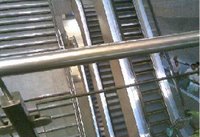DAY 1
The inauguration was done by widely known Dr. Deepak Phatak, who is currently the Chair Professor at KReSIT, IIT Bombay. He enlightened the audience with his ideology on open source software. Eklavya, a project started at IIT Bombay under him was widely appreciated. Next in line where keynotes from Oracle, HP and Red Hat showcasing the usage of open source in there respective firms.
The first presentation of the day was of Google. The Google team talked about there support to the ecosystem of open source. A considerable part of the talk was based on various open source awards given away by Google; the best being Google’s ‘Summer of Code’… (In the interest of students) this event from Google had a placement upto the figure of 84%.
Presentation from Mr. Bebo White, a professor from Stanford University was based upon web applications especially web 2.0 and got a great deal of attention.
Infosys prepared an exhaustive talk on the active use of open source in Java, J2EE and also informed about the latest trends and tools used currently.
The most awaited event of the day was the session with cosmonaut turned IT entrepreneur Mark Shuttleworth. He and his product, Ubuntu (ya!! an interesting name…meaning ‘peopliness’) both won trophies at the Linux New Media Awards during the November 2005 Linux World Expo in Frankfurt. He addressed his thoughts about open source and how is he implementing it. The millionaire from South Africa also made enthusiastic commitments of sponsoring projects and hiring in India.
Day 2
Day two was all together THE Fedora day (according to Red Hat, Fedora is its lab version; somewhat like a beta version).
The first stop on the second day was of Novell/SUSE (surprisingly; the second day being the Fedora day). SUSE, a big boy among European IT techies came up with a cool looky, NLD-10 desktop. Mentionable features of NLD-10 – Open office 2.0, Beagle search, Banshee, Fspot, Tomboy and many more. The team also mentioned about there ongoing efforts in improving KDE and GNOME desktops. NLD-10 is also incorporated with MONO, a feature rich development platform for an open source .NET framework implementation.
IMAGINE the POSSIBILITIES! “Next 10 years, you won’t be able to save data (including films, songs, etc.) on our computer. Next 20 years from today, there won’t be any software (for computers) anymore. 30 years from today, there won’t be more computers. 50 years down the line, most people won’t know how to operate computers. And finally 100 years from now, human would be a highly endangered specie…After that, earth’s new tenants would be aliens”…by the way the above mentioned lines are the titles for some of the slides. That’s what you expect in the best and the most entertaining event of the day, which was a keynote session with Mr. Klaus Knopper. Knopper, who is the creator of Knoppix, provided the audience with a highly hilarious philosophical talk and also made a mockery of the present day license system, thereby promoting the concept of free open source software.
THE Fedora Day was celebrated in ‘bits n pieces’. Fedora came up with many informative presentations on different topics like the use of MONO, Fedora translators, process of localization, etc. Fedora day ended with an address from Christopher Bizzard. He pointed out the difficulties in creating drivers for various peripherals like printers, scanners, etc. He also talked about 3D Graphics and various video cards for making desktop a good experience. Lastly, Fedora declared the release of fc5 (Fedora Core 5) in the next few months.
DAY 3
Day 3 being the last day also had some informal activities amidst the technical talks and various workshops. Many companies were offering various promotional stuff and at one point of time all tech buffs stalls and pavilions were looking like mela stalls (especially the Red Hat stall…thanks to there dartboard game).
Day 3 started with a conference keynote delivered by David Axmark (co-founder, MYSQL) followed by a presentation by Mary Ann Fisher of IBM.
Post lunch session was resumed with a lecture, delivered by Mr. V Ponraj (Director of Interface Technology for the President). His exhaustive lecture touched various aspects of the IT revolution in India. A roadmap of the work to be done in the field of IT till the year 2020 was also presented. In this roadmap, projects like National Identity Card (something on the bases of smart card) were widely discussed. Topics on eGovernance initiatives were also talked about. His presence also gave the opportunity for the big companies to discuss various hindrances which they face in India.
Next on the itinerary list was the discussion with Brian Behlendorf (founder of Collabnet). The Apache guru talked about his current plans on the Apache Web Server. He also expressed his views and thoughts on how a casual user can become an expert and how can a path submitter turn to a core developer in the open source field.
Danese Cooper of Intel and OSI presented the last keynote of the 3 day expo. She promoted the concept of FOSS (free open source software) by giving examples from day-to-day life in a very inimitable style. She also focused on the participation of women in open source world.
So! What was the moral of the trip?
Open source ecosystem doesn’t have CEOs and Managing Directors; it has only VOLUNTEERS (committed to work 24*7).
“Nobody (& Everybody) OWNS the community”. – with this motivating message, LINUX ASIA 2006 ended.











